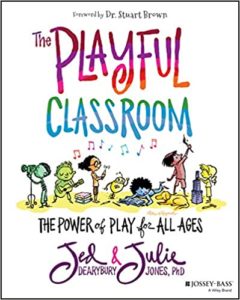It’s Time to Bring Back the Playful Classroom
The Playful Classroom: The Power of Play for All Ages
By Jed Dearybury and Julie Jones
(Jossey-Bass, 2020 – Learn more)
Reviewed by Laura Von Staden

The authors of The Playful Classroom would call that poor pedagogy. They argue that play is an essential component to learning at all ages and point us to research that shows play increases dopamine and serotonin levels which increase our brain’s ability to make neural connections and to retain information.

Play in humans allows us to develop problem solving skills and decision making skills, to learn to work in groups, to share and resolve conflicts. In other words, play is the training ground for surviving and thriving in an ever-changing world.
Drawing on volumes of research showing the importance of play and a playful mindset, the authors provide us with a “startling finding: the average child spends less time outside than the average high security prisoner” (p.152).
In our grading-oriented, standardized testing and accountability educational system we have bred a culture of “checking off the boxes” to get the “A” and the test score. But in the future we will need individuals who are inquisitive, imaginative, creative problem solvers.
Enter the playful mindset
The playful mindset is a process to make learning meaningful and fun, to make students feel valued and appreciated, and to make failure a normal part of the learning process (without consequences).
The book is written in a playful style using lots of “southernisms” (for which there is a glossary in the back of the book), and providing lots of references to research, many useful websites (including their own) to check out, and people to follow on Twitter.
The book easily satisfies its goals of (1) providing research and best practices for a playful classroom; (2) challenging us to confront our instructional choices, and (3) being a resource when our own playfulness well runs dry (p. 240).
When it comes to resources, the authors provide references, TED talks, websites, and a list of other playful educators and how to follow them. They also provide a website of their own that has resources.
Throughout the book there are numerous examples of playfulness in action in the classroom. In addition, the entire last section of the book is filled with challenges to help us meet each of the components of the playful mindset. There are 20 challenges included as well as a reading guide in appendix B.
SO: a playful resource, written in a playful style, but with all the research and resources you need to convince your colleagues and administration to create playful classrooms where students will be filled with joy as their learning and “soft skills” skyrocket. If you decide to get playful, this will be a great book to have on your shelf for support.
Dr. Laura Von Staden is currently a Middle School Gifted Science teacher in Tampa, Florida. She serves on numerous committees in her school district, works closely with the local university, and writes curriculum. She is also a professional development consultant, and previously served as an Exceptional Student Education Specialist, and as a mentor.


































